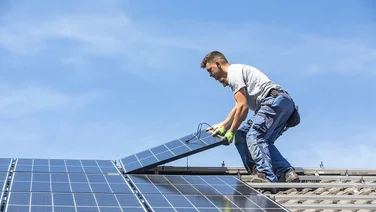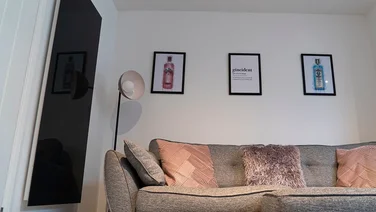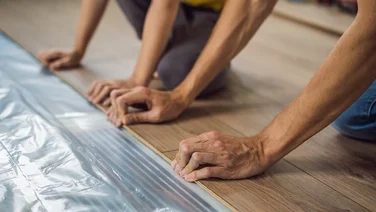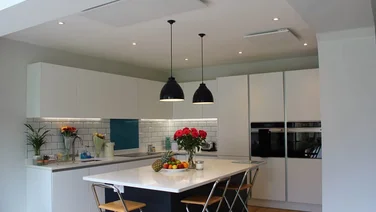- What are infrared heating panels?
- How do infrared heating panels work?
- Why is infrared a good alternative to a gas boiler?
- Is infrared heat safe?
- How much do infrared heating panels cost?
- Types of infrared heating panels
- The advantages and disadvantages of infrared heating panels
- Are infrared panels eco-friendly?
- How popular is infrared heating in the UK?
- Can infrared panels heat water?
- Do infrared heaters use a lot of electricity?
- Can you heat a whole house with infrared heaters?
- Are infrared heaters safe to leave on overnight?
- Summary
- Rather than heating the air, infrared systems heat objects directly
- Panels take about 3-5 minutes to get up to full heat intensity
- The best infrared panels on the market have a rating of 112-115%

Infrared panels are one of the latest low-emission kits that help homeowners heat their properties. They aren’t exactly cheap, though, with the average home spending around £6,000 on infrared heating.
But we think that’s a fair price to pay for lowering your home’s carbon footprint. Keen to learn more about how these handy devices can benefit you? Check out our helpful guide below.
If you think infrared panels would be perfect for your home, our easy-to-navigate tool can help you find the perfect set of panels. Provide a few details, and our expert installers will contact you with free quotes.
Get free infrared panel quotes
Answer a few quick questions, and our trusted installers will send you bespoke infrared panel quotes – for free.

What are infrared heating panels?
Infrared heating is fairly new to the domestic heating scene and works very differently from traditional heating methods.
Rather than heating the room like a conventional boiler does, infrared systems heat objects directly. Radiation is released through large panels propped up on the walls or ceilings, and heat is channeled to specific areas of the property.
These systems use ‘far infrared’ heating panels – but more on that later.
Since infrared heating panels are more efficient than electric and gas boilers, users can cut back on energy consumption at home, potentially leading to savings. Learn more about this on our infrared heating panel costs page.
Although this unique system is currently under the radar, its popularity is predicted to pick up once the government’s gas boiler ban takes effect.
If you’d rather go a different way, you could also consider infrared wallpaper.
What is infrared heat?
Before we discuss infrared heating, it’s important to understand the three types of heat transfer: conduction, convection, and radiation (radiant heating).
- Conduction is the transfer of heat through direct contact in solid materials, like when heat travels along a metal object that’s placed on a hot surface.
- Convection involves heat transfer through fluids (liquids or gases), such as the movement of warm air from central heating radiators.
- Radiant heating (or radiation) works differently. Instead of heating the air, it transfers heat directly to objects and people within its range.
Infrared panels use radiant heating. Because infrared is an electromagnetic wave (similar to light), it can be directed or “focused” over specific distances. Infrared heating can be broadly categorized into two types: near-infrared and far-infrared.
- Far-infrared is gentler, as it heats objects and surfaces rather than the air directly. This makes it safer and more comfortable for home heating. Far infrared technology is commonly used in the infrared heating panels available on the market.
- Near-infrared generates intense heat and is typically used in outdoor or industrial heaters. Its intensity makes it less suitable for extended use in home heating applications.
How do infrared heating panels work?
This is where it gets a bit technical, so bear with us.
Infrared is emitted from the heating panel, which travels through the air until it hits an object. The object absorbs the radiation, causing molecules within it to vibrate and produce heat. In addition to heating the object directly, the vibration re-radiates the warmth back into the room, recycling the heat.
Even humans can absorb this radiation. Once the infrared waves come into contact with us, they will travel roughly an inch into the body, providing a warm feeling.
Although this might seem a little jarring, it’s perfectly safe – but we’ll go into that later.
While infrared panels can work with gas and oil, it’s easier to power them with electricity – this way, you won’t need to integrate any pipework when you install the panels.
Once you’ve got the panels, an installer can hardwire them into an electric circuit, allowing you to use a proper switch (like a light switch) to turn them on. When the panels are plugged in, they take about 3-5 minutes to reach full heat intensity, so you won’t need to wait to get warm.
You can get similar results by installing infrared underfloor heating, which involves placing film panels under your flooring.

Why is infrared a good alternative to a gas boiler?
The main reason infrared trumps gas boilers is its high efficiency—some of the best infrared panels on the market have a rating of 112-115%, as opposed to just 100%.
Most heating systems deliver most of their heat through something called convection, which is effective but also pretty wasteful. This is when heat is transferred into the air, which heats the people in that room.
Conversely, radiant heaters eliminate the middleman (the air) by transferring heat directly from the heater to the people in the room.
On top of this, you’re more likely to stay warmer for longer with infrared heating. Convection heating is easily lost through draughts or opened doors and windows.
Radiant heat, however, heats objects which can’t escape through a draught. Infrared also uses a lower wattage than other heating solutions since it effectively recycles the heat without letting it get lost to draughts.
Another major difference is that infrared heating panels can’t heat water, while gas boilers can. However, you can couple infrared panels with a traditional electric immersion heater or water cylinder.
Despite the benefits of this low-carbon tech like radiant heaters, according to our latest National Home Energy Survey, only 37% of people in the UK have invested in LCT over the last 12 months.
Is infrared heat safe?
When we talk about infrared and radiation entering objects and humans, it can lead a lot of people to worry – after all, it sounds an awful lot like Hulk’s superhero origin story.
Thankfully, there’s no need to worry since this heating method’s type of infrared radiation is 100% natural and risk-free. This is how the Sun heats the Earth, for example.
The far-infrared radiation given off by infrared panels is the same type of heat given off by our bodies – that’s why we absorb it so easily. It’s so safe that it is even used in incubators for babies.
Infrared heating can be healthier than gas heating for people with dust allergies or asthma. While conventional radiators heat the room by moving the air around it, infrared radiation only heats objects, meaning the air doesn’t move around, and dust isn’t disturbed.
How much do infrared heating panels cost?
The typical price of an infrared heating panel is around £495, but this figure will fluctuate depending on the type of panel you choose, its size, design, and wattage. For example, larger panels with higher wattage or custom designs (such as printed or mirrored panels) may cost more.
To fit infrared panels in a four-bedroom house, you’d be looking at an overall cost of about £6,000 for the panels and installation. For a three-bedroom home, the cost would typically be a bit lower, around £4,500–£5,000, depending on the number and size of panels required.
Radiant heating panels are highly efficient and cost-effective compared to traditional heating systems in terms of running costs. For a typical three-bedroom home, running costs are estimated to be around £30–£50 per month, assuming an average usage of 5–6 hours per day and current electricity rates of approximately 24.5p per kWh.
To give you a rough idea, a 600W infrared panel running for 6 hours would use around 3.6 kWh daily. At 24.5p a kWh, that tots up to about £88p a day.
Since infrared heaters are easy to install, many suppliers now include installation costs in the purchase price when you buy directly from them.
Of course, these are just estimates. If you want a better idea of how much-infrared panels will cost, try our personalised quote tool. Simply fill in the form, and we’ll connect you with trusted installers who can provide you with free bespoke quotes.
Alternatively, you can learn more by checking out our comprehensive guide on infrared heating panel costs.
Can infrared heating save me money?
Infrared heating can reduce heating costs by 30-50%, but this will depend on the construction of your home, the property’s ceiling height, and how well insulated it is.
If you want to save even more money, you can hook it up to your smart meter. Infrared panels can be integrated into the home’s electricity system, which means they can be switched on or off in individual rooms whenever you like.
For more about the prices involved, take a look at our guide on infrared heating panel costs.
Image credit: Cürv
Types of infrared heating panels
When it comes to choosing your infrared heating, you have options for both indoors and outdoors:
| Category | Details |
|---|---|
| Infrared Panels | – Reach up to 90˚C and produce far-infrared heat. – Most efficient for indoor use as this heat type is easily absorbed. |
| Quartz Heaters | – Can reach up to 1500˚C and produce near-infrared heat. – Suitable for outdoor or industrial use due to the intensity of the heat |
As well as considering the type of panel, you’ll also need to think about the different features of the panel, including:
- Printed panels—Printed panels basically turn your infrared panels into interior decor. You can even print your own custom images onto them. Rather than having a plain panel on the wall, why not spruce it up with a photo or artwork?
- Wall-mounted panels – This is the most common way to mount your panel. It’s out of the way and is much more discreet than traditional radiators. Plus, you can stick it on any wall; just ensure no obstructions.
- Suspended-ceiling panels – Not got enough space to pop a panel on your wall? Thankfully, you can also place your panels on the ceiling – this way, you’re less likely to have objects getting in the way.
- Other niche panels – Other panels are designed for specific needs, such as pet heaters – created for kennels and catteries and can come as cheap as £99 – and under-desk panels for workspaces.
If you decide to go for a mirrored panel or one with an image overlaid on it, it won’t negatively affect performance.
The advantages and disadvantages of infrared heating panels
- Reduces household emissions
- Aesthetically pleasing
- Don’t take up much space
- Low maintenance
- More efficient than a gas boiler
- Able to retain heat easier than traditional boilers
- No noise pollution
- More expensive that traditional fan heaters
- There can’t be any obstructions in the way
- They can’t fully replace a boiler
Pros of infrared heating panels
- Low emissions – Infrared doesn’t rely on fossil fuels, which means it can rapidly reduce household emissions. Panels can even be used with renewable energy sources to provide 100% clean heat.
- Aesthetically pleasing – The ability to turn your panels into art or a personal photo makes them a great option for anyone worried about how heating systems will affect their interior. Even without printing anything on them, the panels are sleek sheets of white – much easier on the eyes than a bulky boiler.
- Don’t take up much space – Infrared units are compact so that they can be used in small properties. They can also be designed to provide another function, such as a mirror in the bathroom or as a piece of wall art.
- Low maintenance – There are no moving parts in an infrared system, which means there’s very little risk of wear and tear. They don’t need much upkeep either since there aren’t any air filters to be replaced, no engine to wear out, and no lubrication needed. To keep the unit in tip-top condition, you just have to clean the reflectors every now and then.
- More efficient than central heating systems – Infrared heating provides warmth by heating objects directly rather than heating the air. Plus, the heating effect happens immediately, so you don’t have to wait before getting warm
- Retains heat well – Since infrared heaters warm solid objects, it’s able to retain heat better than central heating systems (a system that’s notoriously bad for heat easily escaping through draughts)
- No noise pollution – Infrared heaters don’t have fans, so they stay silent while generating heat.
- Can have health benefits – Infrared heating doesn’t circulate air like conventional heating systems, which can benefit people with asthma. Infrared supplier Heschel published a case study about this benefit. The individual in the study claimed that after installing infrared heating, the house was no longer damp, and he “is certain that his children’s asthma problems have significantly reduced since the renovation.”
Cons of infrared heating panels
- More expensive – You can expect to pay about twice as much for the whole infrared system compared to traditional boilers. However, you should make your money back in a little over a year, thanks to the amount you’ll save on bills.
- There can’t be any obstructions – To feel the true benefits of the heating panel, there shouldn’t be anything in front of them, which is not always easy to achieve
- They can’t fully replace a boiler—Given that infrared panels can’t heat water, while gas boilers can, they won’t be able to fully replace a boiler. You’ll probably have to look into another green option, such as solar thermal heating, to get hot water. Some companies are starting to change this by looking into infrared-water-heating technology, so watch this space.
Are infrared panels eco-friendly?
Infrared heating panels are far more eco-friendly than gas and oil boilers, as they rely on electricity. However, this doesn’t necessarily make them green, as electricity in most countries is generated with fossil fuels. For example, in August 2022, 47.7% of electricity was generated from natural gas.
But if a user has a renewable energy tariff or a set of solar panels on their roof, they can use 100% clean heat. You can learn more about this in our helpful guide: Can Solar Panels Heat A House In The UK?
In addition, infrared panel owners can use less energy heating their homes, thanks to the panels’ high-efficiency rating—some of the best-infrared panels on the market have a 100% rating.
How popular is infrared heating in the UK?
Infrared heating isn’t very popular in the UK at the moment. In 2019, there were only 33,399 UK homes that had infrared heating – or, in other words, 0.04% of the country.
However, since the government has announced its plans to cut household emissions, it’s only a matter of time before homeowners need to ditch their gas boilers and look for alternatives.
Can infrared panels heat water?
Unfortunately, infrared panels can’t heat water, which means they currently aren’t able to fully replace a gas boiler.
As an alternative, users can couple infrared panels with a traditional electric immersion heater or water cylinder – but this will add a few thousand pounds onto the upfront price tag.
Do infrared heaters use a lot of electricity?
As previously mentioned, infrared radiant heating panels are relatively efficient in terms of electrical usage. However, like any heating system, the amount they use will depend on your household’s heating habits.
These panels can convert almost all electricity they “draw” into usable heat, meaning they are less wasteful than other types of heating like gas boilers. Standard electrical heating panels are similarly efficient but are more wasteful regarding how that heat is transferred to the people in the home, namely by heating the air rather than the person directly.
For this reason, radiant heating panels need less “power” than standard electrical heaters and can do the same job for less. To give you some idea, a traditional electrical heater often uses 1.5kW or more.
Infrared panels typically range from 300W to 900W, meaning they use less electricity to do the same job over the same time period.
Infrared heaters, therefore, are not inherently “high electricity users” compared to other electric heating systems. Their efficiency, ability to provide targeted heat, and lower wattage make them cost-effective when used correctly. However, as they rely solely on electricity, the running costs depend on local electricity rates and your usage habits.
Can you heat a whole house with infrared heaters?
You most certainly can. Each panel comes as a standalone unit, but you can buy ceiling-mounted, wall-mounted, or specialist panels to install in all rooms of your home.
Many manufacturers also supply central control hubs, thermostats, and other tools that allow you to intelligently fine-tune the panels throughout the day and seasons.
Are infrared heaters safe to leave on overnight?
Yes, they are, so long as they are used as instructed. Since they are all-electric, they don’t have the carbon monoxide risks associated with combustion heating systems like gas heaters.
Most, if not all, infrared heating panels come with built-in temperature controls and even timers that prevent them from overheating if left unattended. They are also typically designed to be cool to the touch, meaning they won’t set something on fire if in contact with it.
You should only consider buying panels that meet international or national safety standards, like CE-certified products. If you intend on leaving them on overnight while you sleep, you should also ensure you set timers and thermostats to ensure the panels turn off after a certain temperature is reached.
You should also ensure the panels are not directly focused on flammable fabrics or furniture and never cover them with clothing or towels. While low risk, this kind of activity could pose a fire risk.
It is also a good idea to check the power cords and connections for wear and tear since they are electrical appliances.
In general, infrared heaters are safe for overnight use if they’re high-quality, used correctly, and placed in a safe location. Always read the manufacturer’s guidelines and follow the recommended safety practices for peace of mind.
Summary
- Infrared heating panels use radiant heat to warm objects and people directly, offering a highly efficient and low-emission alternative to traditional gas boilers.
- They are versatile, with options for wall-mounted, ceiling-mounted, and even decorative panels. With proper installation and control systems, they can heat entire homes.
- Infrared panels typically range from 300W to 900W, making them cost-effective and less energy-consuming than conventional electric heaters.
- Although the initial setup cost for a typical home can range from £4,500 to £6,000, running costs are estimated to be £30-£50 per month, depending on usage and insulation.
- Infrared heating is considered safe, and panels featuring built-in thermostats and cool-to-touch designs are suitable for overnight use when installed correctly.
- While they can’t heat water like gas boilers, they work seamlessly with other systems and are eco-friendly when powered by renewable energy sources.
Infrared is the underdog in the home-heating game. As the UK government sets to ban gas boilers from 2025 onwards, people are having to look for different ways to keep their homes warm – and infrared is one of the best options waiting for them.
Think infrared panels would be perfect for your home? Find the perfect set of panels by using our easy-to-navigate tool. Simply pop a few quick details in the form, and our expert installers will be in touch with free quotes.






